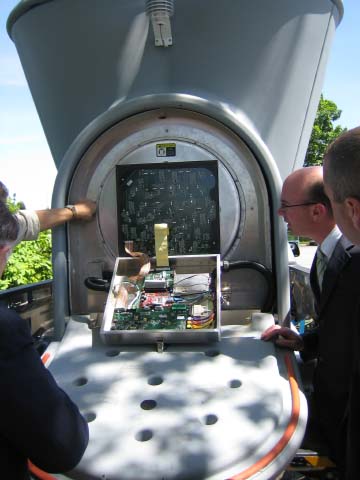June 5, 2009
A. Study to determine if winds are strong, steady enough
 Sonic Wind Profiler: James Hunt III, the city's chief of Environmental and Energy Services, inspects the mechanism of a Triton Sonic Wind Profiler. Photo by Mike Deehan
Sonic Wind Profiler: James Hunt III, the city's chief of Environmental and Energy Services, inspects the mechanism of a Triton Sonic Wind Profiler. Photo by Mike Deehan
The wind turbine outside IBEW local 103 in Dorchester may be getting some company if a new study shows that the wind blowing by one of the prominent Boston Harbor Islands has power-generating potential.
Phase one of the study, checking the wind gusting by Moon Island in Quincy Harbor for velocity and consistency, was completed last week and will be a key element in validating the construction of a wind turbine there. City officials and experts in the field of wind energy will continue their probing into the viability of the project.
“First is to examine feasibility both from a technological perspective, from an air and space perspective, a permitting perspective, and also to examine the cost-benefit feasibility,†said James W. Hunt, III, Environmental & Energy Services Chief for the city of Boston.
State-of-the-art wind measurement equipment, the Triton Sonic Wind Profiler, was placed on the island to determine wind speeds at the site. Instead of the traditional tower-based measurement system, the Triton uses a portable and relatively compact unit to emit sound waves which return to the sensor and generate scientific readings. It can be used repeatedly at different sites and fits easily in the bed of a pickup truck for transport.
“Consider this the equivalent of a 120-foot wind tower in the back of a pickup truck that installs in about two hours,†said Larry Letteney, chief operating officer of Second Wind, a company specializing in wind measurement technology and software.
If a turbine is built on the island, it could be as powerful as 250 kilowatts and could generate up to two and a half times the electricity delivered by IBEW Local 103’s 100kw turbine, Hunt said. Since Moon Island, which now serves as a training center for the Boston Fire Department, is tied to the local power grid, experts say a wind turbine on site could generate enough electricity to power about 125 homes.
Second Wind donated use of the sensor on Moon Island to the city, a value of some $15,000 for the 90 days the Triton was on loan. The remainder of the ongoing study is being funded by a $21,500 grant from the Renewable Energy Trust, a part of the Massachusetts Technology Collaborative.
The next phase will be conducted by Weston & Sampson, the company that will interpret Second Wind’s data as well as investigate logistical details like zoning, possible aviation hazards, and impact to the environment and wildlife. After completing its analysis, the team at Weston&Sampson will issue a report to the city with its findings and recommendations. “We hope to get things wrapped up this summer, maybe July, for our initial report,†said Weston&Sampson’s senior manager, Eric G. Nelson.
Hunt said that if Boston decides to begin construction of turbines on the island, the project will probably be paid for through city bonds, a third-party developer, or some other yet-to-be determined source of funds.


